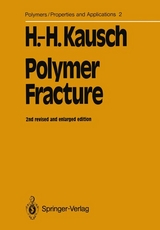Polymer Fracture
Springer Berlin (Verlag)
978-3-540-13250-9 (ISBN)
- Titel ist leider vergriffen;
- Artikel merken
1 Deformation and Fracture of High Polymers, Definition and Scope of Treatment.- References.- 2 Structure and Deformation.- I. Elements of the Superstructure of Solid Polymers.- A. Amorphous Regions.- B. Crystallites.- C. Superstructure.- 1. Spherulitic Structure.- 2. Oriented Lamellar Structures.- 3. Ultra-high Modulus Polymer.- 4. Globular Aggregates.- 5. Block Copolymers and Blends.- D. Characterization.- II. Deformation.- A. Phenomenology.- 1. Thermoplastic Polymers.- 2. Elastomers.- 3. Phenomenological Theory of Viscoelasticity.- B. Molecular Description.- III. Model Representation of Deformation.- References.- 3 Statistical, Continuum Mechanical, and Rate Process Theories of Fracture.- I. Introduction.- II. Statistical Aspects.- III. Continuum and Fracture Mechanics Approach.- A. Classical Failure Criteria.- B. Fracture Mechanics.- C. Continuous Viscoelastic Models.- IV. Rate Process Theories of Fracture.- A. Overview.- B. Eyring’ Theory of Flow.- C. Tobolsky-Eyring.- D. Rule of Cumulative Damage.- E. Early Theories of the Molecular Weight Dependency of Strength.- F. Effect of Volume Concentration of Primary Bonds.- G. Zhurkov, Bueche.- H. Hsiao-Kausch.- J. Gotlib, Dobrodumov et al.- K. Bueche-Halpin.- References.- 4 Strength of Primary Bonds.- I. Covalent Bonds.- A. Atomic Orbitals.- B. Hybridization.- C. Molecular Orbitals.- D. Multiple Bonds.- II. Bond Energies.- A. Electronic Energy and Heat of Formation.- B. Binding Energy of Exited States and Radicalized Chains.- 1. Electronic Excitation.- 2. Ionization.- 3. Radicalization.- III. Form of Binding Potential.- References.- 5 Mechanical Excitation and Scission of a Chain.- I. Stress-Strain Curve of a Single Chain.- A. Entropy Elastic Deformation.- B. Energy Elastic Chain Deformation Ill.- C. Non-Equilibrium Response.- II. Axial Mechanical Excitation of Chains.- A. Secondary or van der Waal’s Bonds.- B. Static Displacements of Chains Against Crystal Lattices.- C. Thermally Activated Displacements of Chains Against Crystal Lattices.- D. Chain Displacements Against Randomly Distributed Forces.- E. Dynamic loading of a chain.- III. Deexcitation of Chains.- References.- 6 Identification of ESR Spectra of Mechanically Formed Free Radicals.- I. Formation.- II. EPR Technique:.- A. Principles.- B. Hyperfme Structure of ESR Spectra.- C. Number of Spins.- III. Reactions and Means of Identification.- IV. Assignment of Spectra.- A. Free Radicals in Ground High Polymers.- B. Free Radicals in Tensile Specimens.- References.- 7 Phenomenology of Free Radical Formation and of Relevant Radical Reactions (Dependence on Strain, Time, and Sample Treatment).- I. Radical Formation in Thermoplastics.- A. Constant Rate and Stepwise Loading of Fibers.- B. Effect of Strain Rate on Radical Production.- C. Effect of Temperature.- 1. Apparent Energy of Bond Scission.- 2. Rate of Bond Scission.- 3. Concentration at Break.- D. Effect of Sample Treatment.- II. Free Radicals in Stressed Rubbers.- A. Preorientation, Ductility, and Chain Scission.- B. Cross-link Density, Impurities, Fillers.- III. Mechanically Relevant Radical Reactions.- A. Transfer Reactions.- B. Recombination and Decay.- C. Anomalous Decay.- D. Radical and Electron Trapping Sites.- References.- 8 The Role of Chain Scission in Homogenous Deformation and Fracture.- I. Small-Strain Deformation and Fracture of Highly Oriented Polymers.- A. Underlying Problems.- B. Loading of Chains before Scission.- C. Spatially Homogeneously Distributed Chain Scissions.- D. Formation of Microcracks.- E. Energy Release in Chain Scission.- F. Fatigue Fracture of Fibers.- G. Ultra High Strength Fibers.- II. Deformation, Creep, and Fatigue of Unoriented Polymers.- A. Fracture at small Deformations.- 1. Impact Loading.- 2. Fracture at Cryogenic Temperatures.- B. Failure under Constant Load (Creep and Long-Term Strength).- 1. General Considerations.- 2. Kinetic Theories.- 3. Creep Failure.- 4. Creep Crack Development.- C. Homogeneous Fatigue.- 1. Phenomenology and Experimental Parameters.- 2. Thermal Fatigue Failure.- 3. Wohler Curves.- 4. Molecular Interpretations of Polymer Fatigue.- 5. Fatigue-life Enhancement Through Surface Treatment.- D. Plastic Deformation, Yielding, Necking, Drawing.- E. Rupture of Elastomers.- III. Environmental Degradation.- A. Aspects to be Treated.- B. Chemical Attack on Stressed Samples.- 1. Ozone Cracking.- 2. Oxidation and Chemiluminescence.- 3. NOx, SO2.- 4. H2O, Other Liquids.- C. Additional Physical Attack on Stressed Samples.- 1. Physical Aging.- 2. UV.- 3. Particles and ?-Irradiation.- 4. Electric Fields.- References.- 9 Molecular Chains in Heterogeneous Fracture.- I. Linear Elastic Fracture Mechanics.- A. Stress Concentration.- B. Crack Tip Plastic Deformation.- C. Material Resistance and Crack Propagation.- D. Subcritical, Stable Crack Growth.- E. Critical Energy Release Rates.- F. Fracture Criteria.- G. Fracture Mechanics Specimen and Selected Values of Kc, Gc, KIc, GIc (Kcc, Gcc).- II. Crazing.- A. Phenomenology.- B. Initiation of Extrinsic Crazes.- C. Intrinsic Crazing and Stress-Whitening.- D. Molecular Interpretation of Craze Propagation and Breakdown.- E. Response to Environment.- III. Molecular and Morphological Aspects in Crack Propagation.- A. Fracture Surfaces and Molecular Mechanisms.- 1. Thermosetting Resins.- 2. Thermoplastics.- 3. Fibers.- B. Defects and Inherent Flaws.- C. Impact Fracture of Notched Specimens.- D. Fatigue Cracks.- E. Fracture-related Phenomena.- 1. Electro-Fracture Mechanics.- 2. Fracto-Emission.- 3. Mechano-Chemistry.- References.- 10 Fracture Mechanics Studies of Crack Healing.- I. Introduction.- II. Models of Adhesive and Cohesive Joint-Strength.- A. Adhesion and Tack.- B. Joint Strength of Thermoplastic Polymers.- C. Model Description.- III. Experimental Studies.- A. Uncrosslinked Thermoplastics.- 1. Experimental Procedure.- 2. Results and Observations.- 3. Estimation of Diffusion Coefficients.- 4. Reopening of Healed Cracks.- B. Crosslinked Thermoplastics.- 1. Experimental Procedure.- 2. Results of Mechanical Tests and Observations.- 3. Discussion.- C. Polymer Mixtures.- 1. Experimental Results.- 2. Conclusions.- D. General Conclusions Derived from Crack Healing Studies.- References.- Appendix Table A.1. List of Abbreviations of the Most Important Polymers.- Table A.2. List of Abbreviations not Referring to Polymer Names.- Table A.3. List of Symbols.- Table A.4. Conversion Factors.
| Zusatzinfo | XIV, 456 p. |
|---|---|
| Verlagsort | Berlin |
| Sprache | englisch |
| Gewicht | 910 g |
| Themenwelt | Naturwissenschaften ► Chemie ► Analytische Chemie |
| Naturwissenschaften ► Chemie ► Organische Chemie | |
| Technik | |
| Schlagworte | Bruch • Copolymer • Crazes • Elastomer • Epoxidharze • Kunststoff • Morphology • Polymer • Thermoplast • Thermoset |
| ISBN-10 | 3-540-13250-3 / 3540132503 |
| ISBN-13 | 978-3-540-13250-9 / 9783540132509 |
| Zustand | Neuware |
| Informationen gemäß Produktsicherheitsverordnung (GPSR) | |
| Haben Sie eine Frage zum Produkt? |
aus dem Bereich




